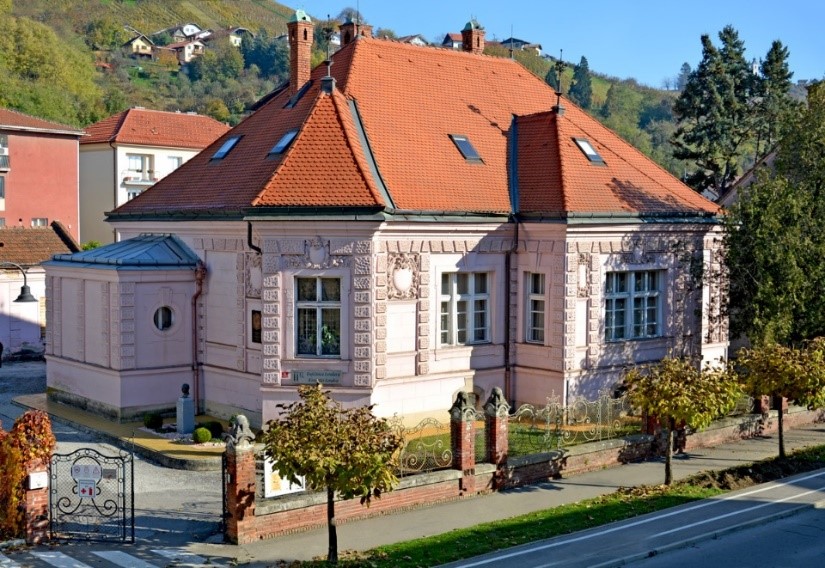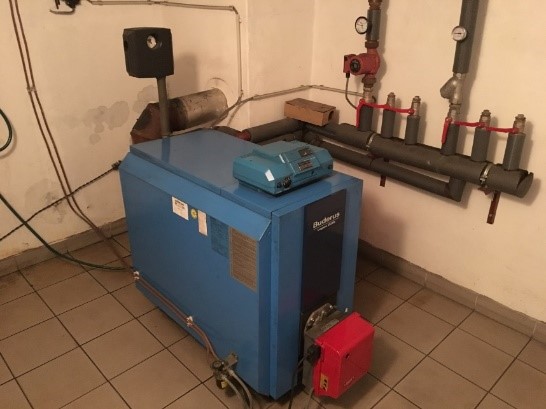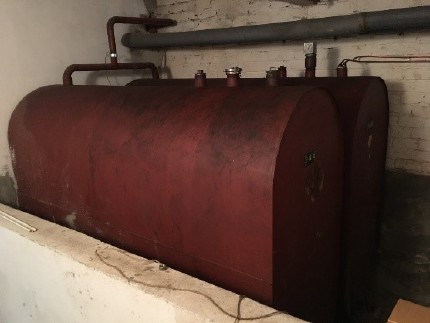Neo-Baroque Villa Receives Renewable Energy Upgrade - The Lendava Pilot
Lendava Library is the location of the the Slovenian pilot installation of Store4HUC. The building, listed as cultural heritage, was built in 1906 in neo-baroque style as the villa of the notary Oskar Laubhaimer presenting an example of holistic concept architecture of the time. The building is still heated by fossil fuel – residual fuel oil, a heating system, that is now planned to be replaced by a system connected to the existing geothermal district heating network combined with paraffin-based energy storing system.

Lendava Library - Oskar Laubhaimer's neo-baroque villa built in 1906
The exterior of this neo-baroque villa is excelled by four four small corner towers , baroque cartouches and a decorative gutter. The interior is characterised by rich stucco ceiling with floral garland ornaments, entirely preserved vitrage windows, floor mosaic and richly ornamented parquetry. The villa now houses the Lendava Public Library with a unique collection of local documents in both Slovenian and Hungarian. In order to preserve the special characteristics of this building, several partial renovation was undertaken during the years: the roof structure was replaced and a 15 cm thick thermal roof insulation was added in 1996, the basement was completely renovated in 200, and the windows were upgraded to wooden, boxed style newly insulated windows. Due to the regulations for monument protection, renovation possibilities on the building however are strictly limited.

Existing inefficient old heating oil boiler
The main aim of the pilot project is to upgrade the energetic characteristics of this historical building by replacing the existing Oil-Fired Boiler with a renewable energy source. The building will be connected to the existing geothermal district heating network to increase the share of renewables in public sector and an innovative solution of energy storing system will increase the level of energy efficiency in public buildings (related to the higher efficiency of the heating system). The energy storage is based on paraffin cells: innovative buffer storages that have been developed to efficiently store heat and cold generated from small irregular energy sources such as solar energy and heat pumps. Thermal energy storage technologies and geothermal district heating systems have the potential to play a significant role in the transition towards 100% renewable energy systems through increasing system flexibility and overall efficiency and thus reduce CO₂ emissions and increase domestic energy security. An additional advantage of such systems is that the heating costs decrease. In case of the Lendava Library, one of the main advantages of the paraffin-based storage vs. to regular water storages is that it takes up less space.

The old heating oil storage tank
Currently the feasibility study and investment specification is being prepared. According to the feasibility study, several issues had to be taken into consideration.
In terms of legal issues, the municipality had to obtain all permits related to: protection of cultural heritage; plumbing; electricity; heating pipe; faecal waters; meteor showers; telephony; cable TV; municipal roads. All permits and official opinions were issued positively.
Technical Issues related to instabile heating supply:
- Lendava Library will be the last connection in the geothermal district heating network and the supply is not stable - the temperatures cannot be constant. Due to the instability of the supply, the fossil fuel- didn´t changed the fossil fuel in this building yet - the storage selection in the pilot is crucial, to change into RES. The properly selected storage will in this case ensure the stable supply for end users.
- A heat exchanger will be installed and temperature sensors will measure the starting and final temperatures. In this regard, this investment can serve as good practice example of innovative solution of storing renewable energy in an effective way, based on a monitoring report using the Autarky Rate Tool energy management tool developed to see the results of the investment (CO₂ savings, kWh savings, cost savings, etc.).
The newly implemented storage in combination with the newly implemented control and EMS system will raise the flexibility of the local heating grid. This enables two new essential operating modes:
- Load balance: The boiler plant can be operated at an advantageous higher base load range instead of continuously at a low fluctuating partial load;
- Peak-load covering: Individual load peaks especially in autumn and spring can be covered by the storage. Therefore, the start-up of an additional boiler, operating at low loads, can be avoided.
In energy terms, the water buffer storage tank used is a proven technology and can be regarded as the most cost-effective solution compared with other storage technologies due to the high number of charging cycles (almost daily complete charging and discharging of the storage facility). Essentially, due to the planned measures of load balancing and peak load coverage, the disadvantageous partial/weak load operation of the boiler plant is avoided or reduced and thus the following positive effects are achieved:
- Increasing the efficiency of the fuel boilers → Savings in primary energy (fuel savings) → CO2 savings through lower energy expenditure for the provision of the wood chips (production, transport, etc.);
- Lower pollutant emissions (carbon monoxide (CO), dust, NOx and volatile organic carbon compounds (CnHm))
- Increasing the service life of the plant components → Significant saving of ecological resources that would result from early complete renewal of the boiler plant;
- Increase in sweeping intervals (due to on/off operation of the boiler system), more time windows are available → Increase in efficiency, reduction in pollutant emissions
- Extension of maintenance intervals → Lower maintenance costs
- More dynamic operation of the local heating network possible → Consumers can be served more quickly with the required flow temperature;
- In addition, the use of the heating network as a thermal buffer is avoided as a result of the central storage in the heating plant and the associated increased heat losses are reduced.
The planned pilot project is carried out in accordance with the current valid Local Energy Concept of the Municipality of Lendava (2012) and the current valid Sustainable Energy Action Plan of the Municipality of Lendava - SEAP (2012).
